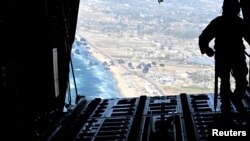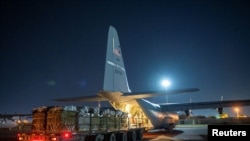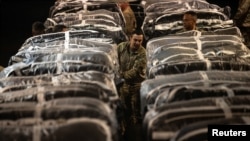President Joe Biden, who announced the operation on Friday, said the U.S. was looking into additional ways to help Palestinians in the Hamas-ruled territory as the Israel-Hamas war goes on.
A look at what to know:
When Did the Airdrops Start?
Three C-130 cargo planes from Air Forces Central dropped 66 bundles containing about 38,000 meals into Gaza at 8:30 a.m. EST Saturday. The bundles were dropped in southwest Gaza, on the beach along the territory’s Mediterranean coast, one U.S. official said. The airdrop was coordinated with the Royal Jordanian Air Force, which has been airdropping food and took part in Saturday’s mission.
More airdrops are expected to follow.
Why Now?
Biden's decision comes after at least 115 Palestinians were killed and more than 750 others were injured on Thursday trying to access aid in northern Gaza under disputed circumstances, according to Gaza’s Hamas-run health ministry. Witnesses said Israeli troops opened fire as huge crowds raced to pull goods off an aid convoy, while Israel has said it fired only when its troops felt threatened and that most of the civilian casualties were from trampling.
The U.S. has been pushing Israel to speed the flow of humanitarian assistance into Gaza and to open a third crossing into the territory, but the violence Thursday showed the challenges no matter the circumstances.
“The loss of life is heartbreaking," Biden said as he announced his decision to order airdrops. "People are so desperate.”
How Will the U.S. Ensure Aid Gets to Where It's Needed?
Asked how the U.S. would keep the supplies from falling into Hamas' hands, White House national security spokesman John Kirby told reporters that the U.S. would learn over the course of the aerial operation.
“There’s few military operations that are more complicated than humanitarian assistance airdrops," he said. Kirby said Pentagon planners will identify drop locations aiming to balance getting the aid closest to where it's needed without putting those on the ground in harm's way from the drops themselves.
“The biggest risk is making sure nobody gets hurt on the ground,” Kirby said. He said the U.S. is also working through how the airdropped aid will be collected and distributed once it's on the ground.
Will It Make a Difference?
The U.S. believes the airdrops will help address the dire humanitarian situation in Gaza, but they are no replacement for trucks, which can transport far more aid more effectively — though Thursday's events also showed the risks with ground transport.
Kirby said the airdrops have an advantage over trucks in that planes can move aid to a particular location very quickly. But in terms of volume, the airdrops will be "a supplement to, not a replacement for moving things in by ground.”
What Else Can Be Done?
The U.S. and allies have tried to broker a new temporary cease-fire between Hamas and Israel that would see the release of more hostages held by the militant group in Gaza, the freeing of some Palestinian prisoners in Israeli jails and an up-to-six-week pause in the fighting. If a ceasefire were secured, the U.S. hopes it would allow large quantities of aid to flow into Gaza over a sustained period of time. Biden on Friday also said the U.S. was working with allies on establishing a “maritime corridor” to provide assistance to Gazans from the sea.




Forum